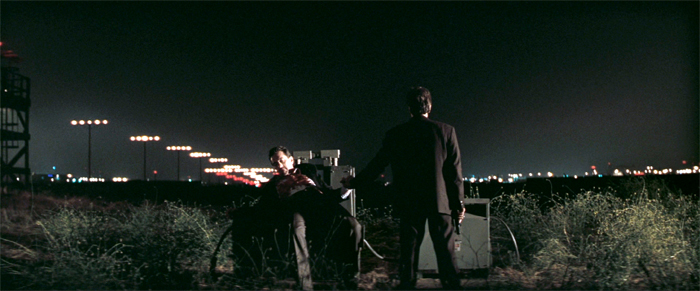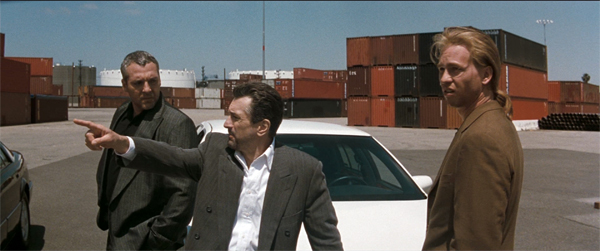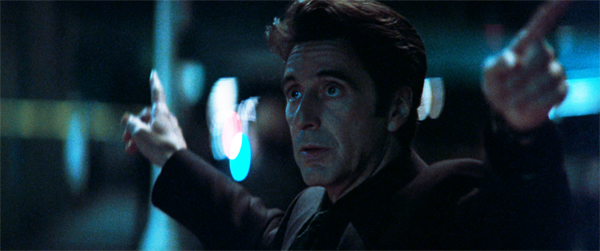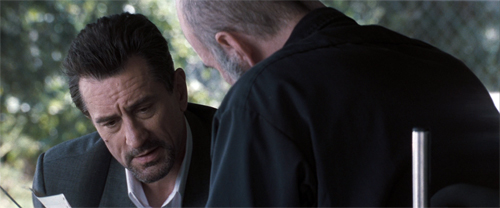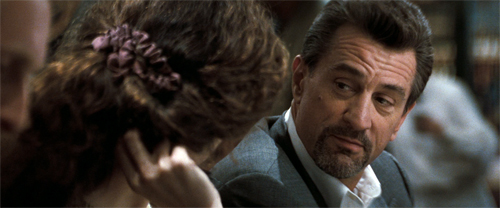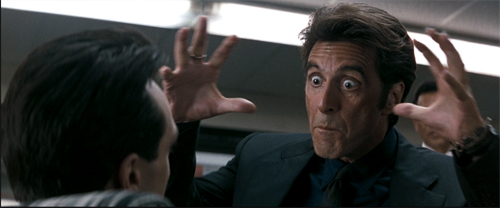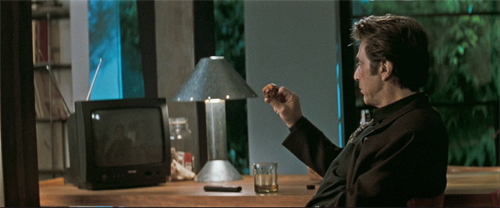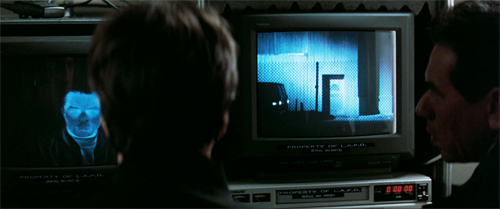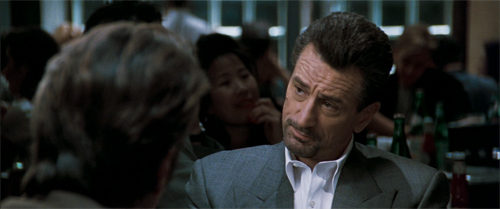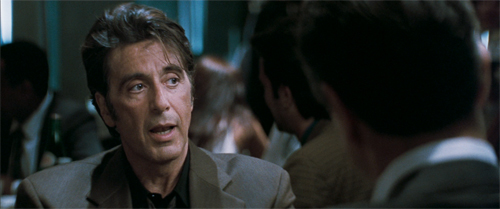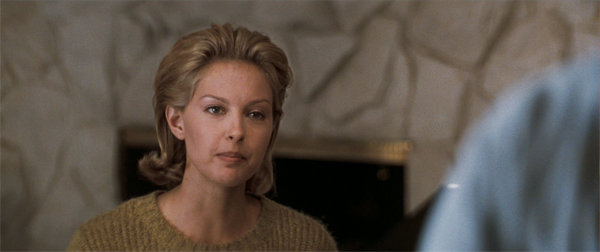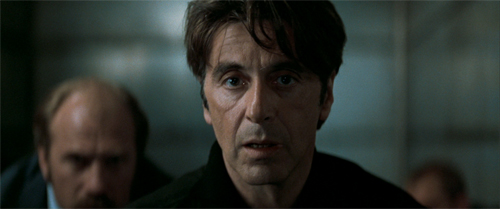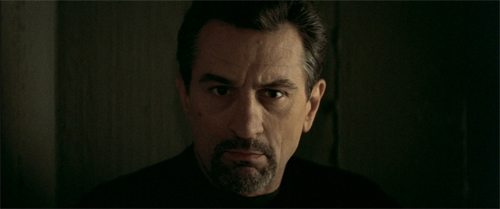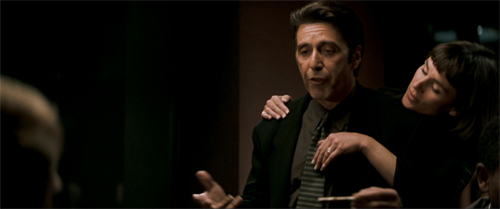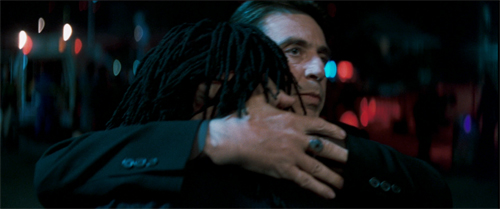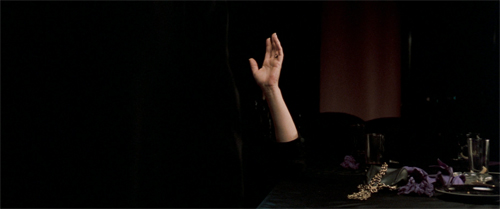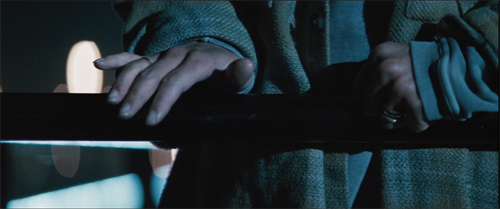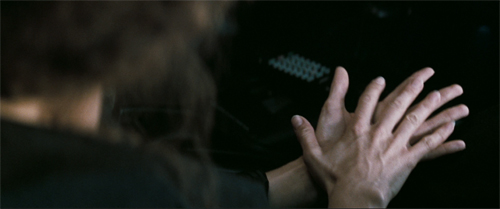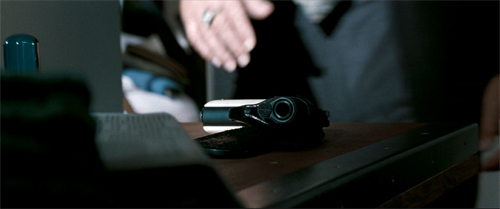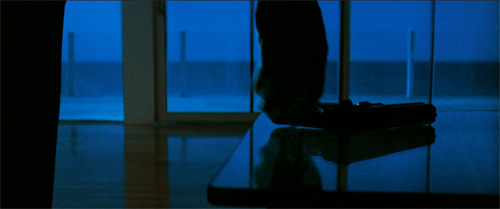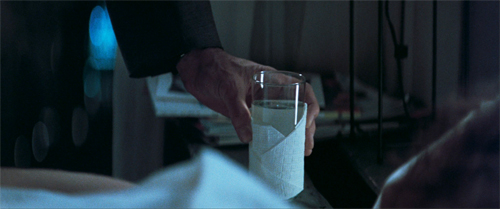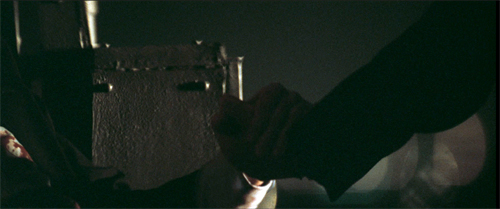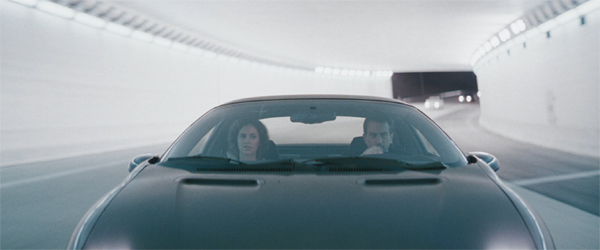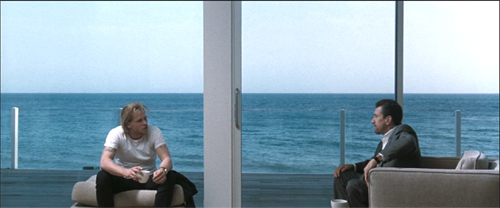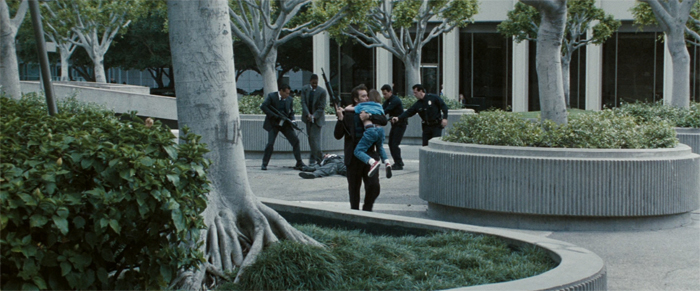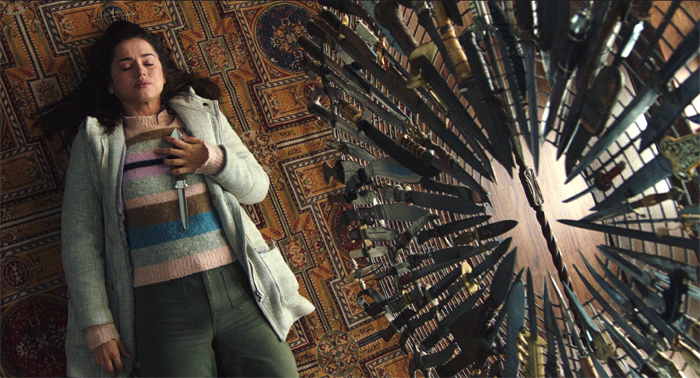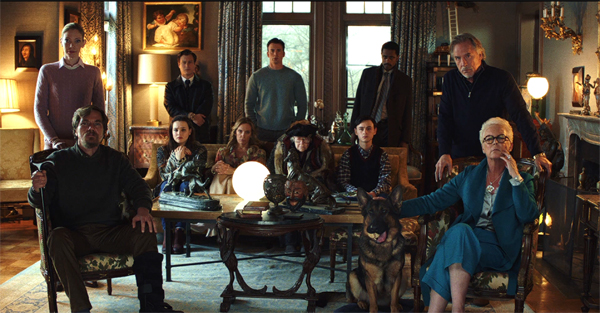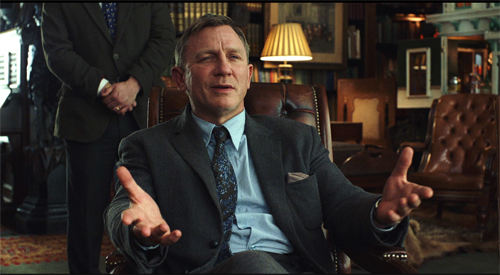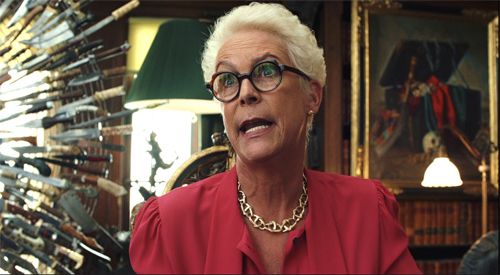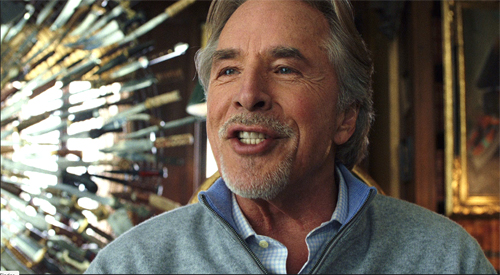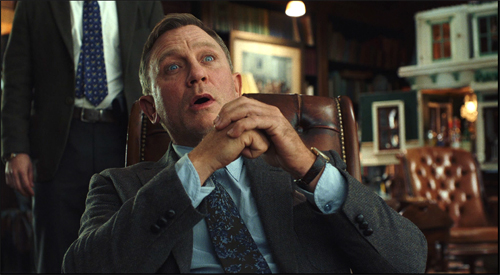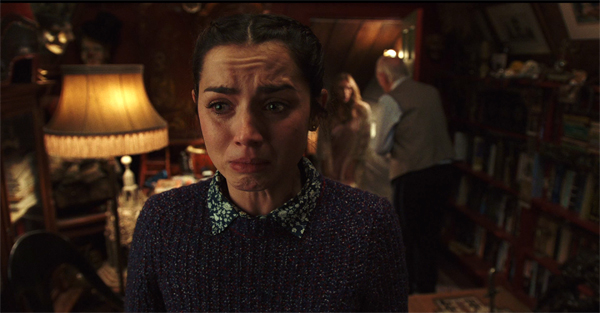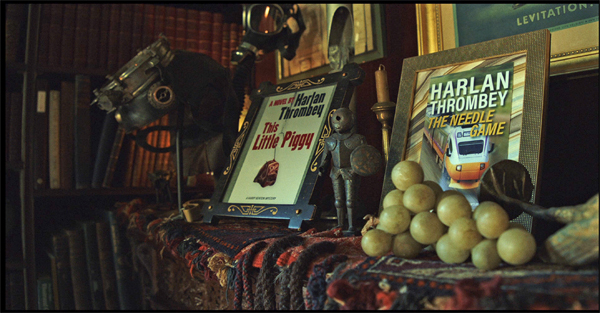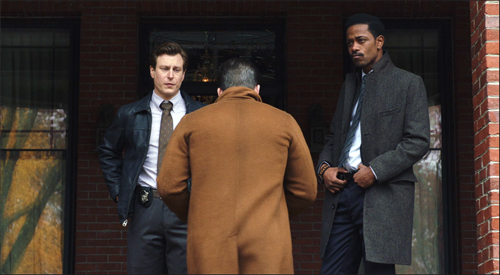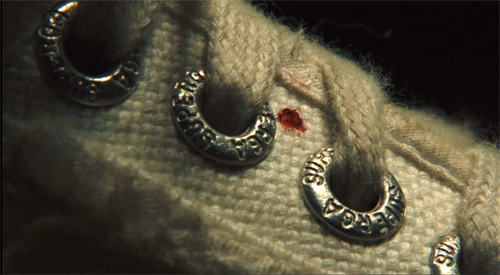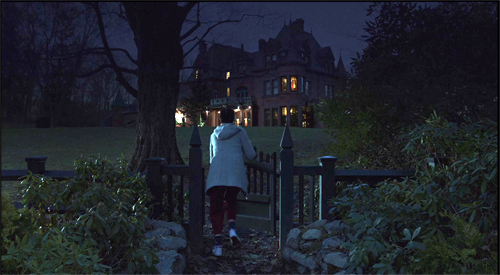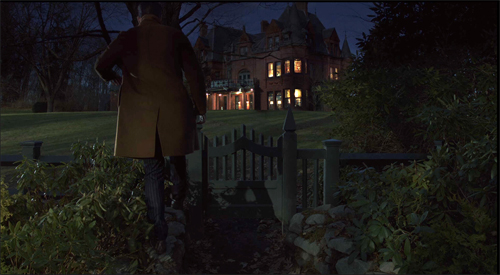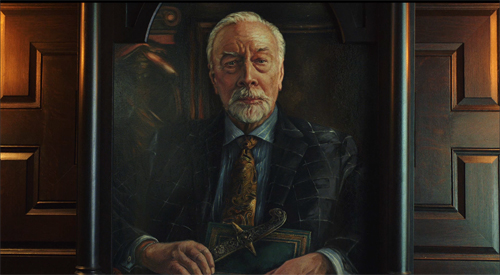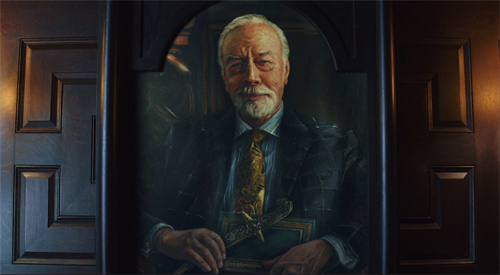Archive for August 2022
HEAT revisited
Heat (1995).
DB here:
Last year, Quentin Tarantino wrote a novel that extended and reconsidered the story of Once Upon a Time . . . in Hollywood (2019). Less elaborate is Michael Mann’s new bestseller Heat 2, written with Meg Gardiner. It’s not his first reworking of his film’s world: Heat (1995) was itself an expansion of a TV movie, LA Takedown (1989). Tarantino’s book was fairly experimental, as I tried to show, but Heat 2 is more conventional, being, as reviewers have mentioned, at once a sequel and a prequel to the original film. Yet it has its own interest, I think, and it provides me a chance to revisit a film I’ve long admired.
You’ve probably seen the film, but I’ll warn you of spoilers when I come to discuss the book.
Two genres for the price of one
In the film, Mann blends two schemas for crime plots: the heist film and the police procedural. What’s remarkable is the way both get expanded and interwoven to a degree rare in each of the genres.
The heist plot centers on Neil McCauley’s gang, consisting of Chris Shiherlis (Val Kilmer), Michael Ceritto (Tom Sizemore), and Trejo (Danny Trejo). The team members are married, and two have children. McCauley (Robert DeNiro) is a loner, living by the code that by being free of personal ties he can escape when the police close in.
In the course of the film, the gang plans three scores. The first, in the opening, is a robbery of an armored truck. Being short-handed, McCauley has had to add another team member, the sociopath Waingro, to consummate the heist. This robbery will reverberate through the film. Waingro shoots one of the truck drivers, forcing the gang to kill all of them. By seizing the bearer bonds of the money launderer Roger Van Zant and trying to sell them back to him, the gang sets off a cascade of broken deals and violent confrontations. McCauley fails to kill Waingro as punishment for damaging the heist, and Waingro emerges to help Van Zant stalk McCauley.
The second score, an effort to access precious metals, is aborted when McCauley realizes that the police are monitoring their preparations. The third score is a brutal bank robbery in which the team is virtually wiped out, with only McCauley and Chris surviving.
The heist plot adheres to many of the phases I’ve sketched in an earlier entry on the genre. The jobs are set up by the fence Nate and the computer whiz Kelso. The gang meets to plan each attack, with a division of labor among them. As often in the genre, the private lives of the robbers intervene. Chris, a gambling junkie, is in a fraught marriage with Charlene (Ashley Judd). Before the last score, McCauley advises Ceritto to walk away, since his wife Elaine takes good care of him. For the bank job McCauley recruits a prison pal Don Breedan (Dennis Hastert), whose wife Lilian (Kim Staunton) tries to sustain his effort to hold a job. And after Waingro kills Trejo’s wife Anna, the fatally wounded Trejo feels nothing left to live for. Most risky of all is McCauley’s growing love for Eady (Amy Brenneman), who makes him inclined to relinquish his solitude and unite with her after the bank job.
Braided with the heist plot is an investigation plot centering on homicide lieutenant Vincent Hanna (Al Pacino). He’s brought in through the armored-car murders and begins systematically to trace leads to the gang. In the usual procedural fashion, Hanna and his colleagues visit snitches, search records, tail and tape suspects, and gradually identify the gang. It’s their botched surveillance that induces McCauley to drop the second score. There emerges a game of tit-for-tat, as the gang in turn surveils the police and use their informants in the police to identify Hanna.
Police procedurals often fill out the action with scenes of the cops’ personal lives, and here that function is fulfilled by a portrait of Hanna’s failing marriage to Justine (Diane Venora) and his effort to nurture Lauren (Natalie Portman), their teenage daughter from another marriage. As the robberies test the family relations of the crooks, Hanna’s commitment to the investigation drives home to Justine his emotional distance and his refusal to open up to her about how he reacts to the crimes he encounters. Further intertwining the two plotlines, Hanna must also investigate the latest in a string of serial murders of prostitutes. We will learn that the killer is Waingro.
We might think of Hanna as the protagonist, with McCauley as the antagonist. But the weight given McCauley and his plotline inclines me to say that the film has two protagonists. Each is an antagonist to the other, with subsidiary antagonists (Waingro, Van Zant) adding pressure to the conflicts. Each man stands out, of course, by virtue of the presence of major stars. The performances are carefully calibrated. As McCauley, Robert DeNiro underplays to the point of paralysis: he acts mostly with the space between his hairline and his eyebrows.
By contrast, Al Pacio’s Hanna is full of swagger and bravado, using what Mann calls “manically extroverted” gestures and speech to intimidate others. But that’s on the job. At home, he’s taciturn, justifying his impassivity there as a way to preserve his angst and keep his edge for the street.
Mann’s screenplay teases us with brief confrontations between the two men. One takes place via surveillance video during the second score.
The most famous encounter is the celebrated diner scene, handled in protracted over-the-shoulder views. Here Hanna is much more subdued, modulating his eye movements to match McCauley’s constant scanning of the room.
The two plotlines culminate at the airport. McCauley interrupts his escape to kill Waingro and, reverting to his “discipline” of abandoning personal ties, must leave Eady alone. But he’s pursued by Hanna for a final shootout.
Apart from its binary-protagonist structure, the sweep of the film also makes it something of a network narrative. There are a great many characters and locales, and nearly every scene is elaborated in such physical detail that we have a wide-ranging survey of vivid personalities and situations. I haven’t mentioned the memorable informers whom Hanna interrogates, or Charlene’s louche lover Marciano, or Dr. Bob, the veterinarian who patches up the wounded Chris. Even the smallest roles (often played by recognizable actors) gain a memorable intensity. The breadth and depth of the story world suggests that the film might be a prototype for the “mosaic” structure of TV series like The Wire (20002-2008).
Work/ life imbalance
Narratives cohere largely through patterns of causality. One incident triggers another. But narratives also depend on parallelism–likenesses and difference among aspects of the story world. Parallels can draw comparisons among characters, locales, and situations. Michael Mann deliberately built Heat on parallels, as he points out in the 2005 DVD commentary track.
Most obvious is the comparison of Hanna and McCauley as men devoted to their work, at the expense of intimate relationships. (Parallels between cop and crook are virtually a convention of the policier.) Each man’s willed solitude is virtually a compulsion, and they recognize their affinity in the diner conversation. That is prepared for by almost telepathic reverse angles during the video surveillance, with the lighting’s angles presenting them as virtually split.
One benefit of the expansive plotting of the film is the way it creates parallels to other men. Nate, Kelso, and Van Zant seem as isolated as McCauley, though perhaps not out of principle. At the extreme is Waingro, also a loner, but one who preys on women–a psychopathic alternative to McCauley’s asceticism.
The film multiplies parallels among the couples. Ceritto has a warm relationship with his wife, and Trejo chooses death over life without Anna. Chris, for all his faults, is deeply in love with Charlene. Breedan responds resolutely to Lilian’s urging to reconcile himself to the unfairness of his new job.
Likewise, Hanna’s police colleagues are happily married. In parallel scenes, we see the gang and the squad enjoying lively restaurant dinners. Even Hanna unbends enough for a dance with Justine. Only McCauley, alone with the other couples, is marked as without a woman–a status that impels him to call Eady and invite himself over.
There are plenty of other parallels, not least that of vulnerable daughters, with the suicidal Lauren and the teenage hooker Waingro kills. But the ones I’ve just examined point up a common feature of classical Hollywoood plotting. Often American studio films interweave two lines of action, one based on work and another based on romantic love. Problems arise when the two can’t be reconciled. The husband may be consumed by pressures of the job, while the wife is neglected and her wishes dismissed.
More specifically, cop films and novels often play out the conflicting demands of duty (danger, disruption of routine) and love (of wife and children). This is exactly the life that McCauley foreswears and that Hanna tries to negotiate. The crux of the film is that both McCauley and Hanna entertain the possibility of a normal life only to find that their nature precludes it. Their counterparts seem to have managed it, but each gang member is also drawn to the adrenalin high of crime. “For me,” Ceritto says, “the action is the juice.” They all go along with the bank heist, with ruinous results. To a lesser degree, they are on the same spectrum as McCauley and Hanna.
The work/life tension is sometimes made apparent on the level of style. After Hanna dances playfully with Justine, Mann interrupts with the next scene, in which Hanna blocks the distraught mother from approaching her daughter’s corpse.
There is deeper concern, to the point of passion, in Hanna’s frantic embrace of this grieving stranger than in his flirtatious dance with his wife.
In such ways the film spares sympathy for the women. The plot brings out the parallel situations showing women beseeching the men to face their problems. Mann also uses visual motifs to heighten the comparisons. The women express themselves in shots of their hands. A bold composition in which Hanna blocks Justine heightens her gesture of annoyed resignation, and later close-ups show Charlene’s secret signal to Chris and Eady’s tension while waiting at the airport.
Men’s hands have other things to do, although one close-up of Neil fetching water for Eady suggests the man he might become.
The climax of this motif comes at the end, as Neil lies dying and Hanna accepts his handclasp.
Scrambled backstory
Now the spoilers for the novel commence.
In planning Heat 2 Mann and Gardiner faced some problems. At the end of the film several characters are dead, including the fascinatingly reticent Neil McCauley. To revive him, you have to create his backstory. Chris Shiherlis and his wife Charlene survive, but she has chosen not to give him to the police, so he will have to find a new way to live. And how will you treat Vincent Hanna–his past, his future?
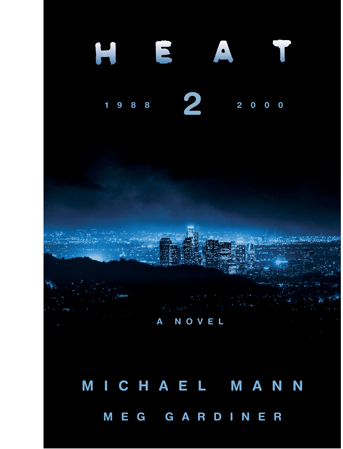 The authors found several solutions, some of which vary Mann’s usual narrative strategies. The novel is broken into time periods, but not in the manner of the prototype for such sagas, Godfather II (1974). After a prologue sketching the action of the film, one section is devoted to the immediate aftermath of the bank robbery. This alternates Chris’s escape from LA and Hanna’s inability to track him.
The authors found several solutions, some of which vary Mann’s usual narrative strategies. The novel is broken into time periods, but not in the manner of the prototype for such sagas, Godfather II (1974). After a prologue sketching the action of the film, one section is devoted to the immediate aftermath of the bank robbery. This alternates Chris’s escape from LA and Hanna’s inability to track him.
There follows a flashback to 1988, set mostly in Chicago, in which McCauley and his crew launch new heists. These scenes alternate with episodes of Hanna, stationed in Chicago, investigating some brutal home invasions. Eventually the gang executing the invasions learns of McCauley’s plans for a southwestern raid on drug smugglers and decides to rip off the team. The initiative is led by the monstrous Otis Wardell, a Waingro on steroids, who enjoys raping the women whose homes he invades. Ultimately Hanna’s frustration with his boss’s constraints on his investigation leads him to quit the force.
Most Mann films are resolutely linear in plotting. Apart from the time-jumping montage at the start of Ali (2001), he prefers chronological narrative. But now Heat 2 jumps ahead to 1995-1996. Chris has fled to Paraguay, where he takes up with a Taiwanese family involved in the arms trade and cybercrime. He falls in love with the chief’s daughter Ana, whom he helps gain power in the family.
The action returns to the southern border in 1988, with a showdown between Wardell and McCauley. In the course of a protracted firefight, Wardell kills Elisa Vasquez, the woman McCauley loves. Losing her is what plunges McCauley into the willed solitude that he projects in the film.
After another passage from 1996 bringing Chris and Ana up to date, the action jumps to 2000, after the events of the film. Everyone is now back in Los Angeles, and Hanna, remembering Wardell from his Chicago days, vows to capture him, while Chis vows to kill Hanna in revenge for McCauley’s death. Complicating things is the presence of Gabriela, Elisa’s daughter, who becomes a new target for Wardell. All these forces converge at a bloody climax.
Why did Mann break the prequel material into blocks and alternate the time periods? I suspect it was to maintain interest in the runup to the film’s action. If all the 1988 action preceded Chris’ 1990s career in Paraguay, we would have lost both McCauley and Hanna about a third of the way through the book. Chris would have had to carry a large central chunk of the story. Even as a soldier of fortune, he just isn’t as charismatic as Hanna and McCauley, so holding the resolution of the McCauley plotline in suspension keeps us turning the pages. Elisa’s death and McCauley’s devastation provides a strong lead-in to the film we have. Thereafter, the 2000 followup serves to wrap up nearly all the action. (The last line presents is a dangling cause that could lead to yet another sequel.)
The novel is less concerned with parallels than the film, although Ana’s frustration with the closed-in Chris matches that of Heat‘s wives. And Hanna’s fury at Wardell’s rape and beating of a teenage girl fuels his mission to find the gang, while thanks to a coincidence Wardell realizes that the waitress in a diner is the daughter of the woman he murdered in the desert. What knits the novel together most tightly is the premise that Hanna, McCauley, and Wardell were all in Chicago in the same years, but they were largely unaware of each other. We see links that the characters aren’t aware of.
This roaming-spotlight viewpoint is at work in the film as well, with the constant crosscutting of cops and crooks. But Mann and Gardiner take omniscience farther by penetrating the minds of the characters. Scene by scene we learn what the major characters are thinking, with some scenes containing several shifts of perspective. It would be as if the film gave us voice-overs from Hanna, McCauley, Chris, and others. The novel’s inner monologues remind me of Mann’s commentary track for Heat, which frequently draws larger conclusions and fills us in on what the characters are thinking. When Drucker pressures Charlene to give up Chris, Mann’s commentary reminds us that he’s trying to “build emotional solidarity” with her “despite having “a very short window.” Of Heat‘s two protagonists, he says:
These are the only two guys like each other in the universe. . . they are fully aware and conscious of who they are.
In the novel’s prologue the passage is:
Each navigated the future racing at him with eyes wide open. . . Polar opposites in some ways, they were the same in taking in how the world worked, devoid of illusions and self-deception.
The result is a narration that is, by the standards of Hammett or Elmore Leonard, over the top. On the same page, we get: “The detonation behind her eyes is seismic” and “For a second, she looks like she might explode.” Likewise, the perspective-shifting encourages scenes to be overelaborated; nothing is left to the imagination. But as with a lot of pulp writing, the novel has a raw power. We can treat it as a package, wrapping a Mann plot and dialogue in blunt, brash commentary.
Novel as script
A great deal of the appeal of a Michael Mann film is its richly textured surface. He is a “realistic” director insofar as he carefully researches a film’s milieu and takes pride in exact historical details. During a visit to Madison, he praised Dunkirk for Nolan’s attention to the Bakelite knobs on the aircraft. Yet Mann is also a pictorialist, always seeking striking, expressive shots that can de-realize the most familiar landscape, often through long lenses.
His early interest in video capture indicates both his realist impulse and his gift for abstract color design. Wanting to reveal LA at night in Collateral (2004), he wound up with night visions like nothing else on earth. Add in his talent for innovative film music. Heat‘s eclectic, melancholic score, so different from that of the routine action picture, is a big part of its power. So approximating a Michael Mann film on the printed page is far from easy.
Heat 2.0 tries. Written in the present tense, it has the staccato quality of a screenplay.
Gunfire. Deep. A rifle. Behind, them, rounds hit the connecting door from the far side. Somebody kicks it. Chris spins and fires a three-shot burst. They hear a body fall. More shots come through the wood, splintering it.
Reading it, you may find yourself hearing the dialogue in the voice of DeNiro or Pacino.
Ceritto glances around. The walls of boxes gleam in the spooky light. “Which one has the Holy Grail?”
Neil opens a gym bag. “Don’t matter. You find Jesus Christ, haul him out and hand him a sledgehammer.”
Hanna leans down into Alex’s face and grabs the crucifix in his right ear and rips it out through the lobe. Alex screams. Blood pours from the tear.
“Asshole!” Hanna shouts. “What the fuck do you think we’re gonna do? You are gonna flip, you dumb prick. You are gonna tell me everything I want to know, you cocksucker!”
He jerks Alex’s chin up, stares into his eyes, and shoves forward the cross. “The power of Christ commands you! I am your motherfucking exorcist. Tell me!”
Mann says he hopes to make a film of the novel. If he does, readers will hope that passages like these make their way into it.
Heat has proven to be an enduring modern classic. It’s encouraging that a followup to a movie nearly thirty years old can stir such widespread interest. Whatever happens to Heat 2, it shows that at age 79 Mann has not lost his lustre.
Nick James’s appreciative monograph on Heat offers many insights into the film. I discuss the heist genre and the police procedural in my forthcoming book Perplexing Plots.
Heat (1995).
Enter Benoît Blanc: KNIVES OUT as murder mystery
Knives Out (2019).
DB here:
Now that a sequel, Glass Onion, has been announced for the Toronto International Film Festival, it seems a good time to look back at Rian Johnson’s first whodunit Knives Out. The effort has a special appeal for me because it chimes well with arguments I make in Perplexing Plots: Popular Storytelling and the Poetics of Murder.
I don’t analyze Knives Out in the book, but it would have fitted in nicely. The movie exemplifies one of the major traditions I study, the classic Golden Age puzzle, and it shows how the conventions of that can be shrewdly adapted to film and to the tastes of modern viewers. In addition, Johnson’s film supports my point that the narrative strategies of “Complex Storytelling” have become widely available to viewers, especially when those strategies are adjusted to the demands of popular genres. Historically, such strategies became user-friendly, I maintain, partly because of the ingenuity demanded by mystery plotting.
Needless to say, spoilers loom ahead.
Revisiting and revising
The prototypical puzzle mysteries are associated with Anglo-American novels of the 1920s-1940s, the “Golden Age” ruled by talents such as Dorothy L. Sayers, Anthony Berkeley Cox, John Dickson Carr, Ngaio Marsh, Ellery Queen, and many others–supremely by Dame Agatha Christie. Similar books are still written today, often under the guise of “cozies” because they supposedly offer the comforting warmth of familiarity. Golden Age plotting flourishes in television too, in all those (largely British) shows about murder in supposedly humdrum villages.
Knives Out relies on Golden Age conventions from top to bottom. A rich, odious family is overseen by a domineering patriarch, mystery novelist Harlan Thrombey. When he’s found dead in his mansion, apparently of suicide, his family members become nervous because each has a guilty secret. The conflicts are brought into focus when it’s revealed that Harlan changed his will so as to disinherit all his offspring. He leaves his fortune and his house to Marta Cabrera, the nurse who administered his medications and became his friend and confidant. Is there foul play? Investigating the case are are two policemen and the private investigator Benoît Blanc. They must decide whether Harlan’s apparent suicide is actually murder and if so, who’s the culprit.
Johnson organizes his plot around many classic techniques. In the Golden Age, writers tended to fill the action out to book length by adding more crimes, such as blackmail schemes or a series of murders. Both of these devices are exploited in Knives Out. Marta is apparently the target of an extortioner, and the family housekeeper Fran is the victim of a poisoner. The film also employs the least-likely-suspect convention (a favorite of Christie’s) and a false solution (another way to fill out a book). Johnson supplies traditional set-pieces as well: the discovery of the body, a string of interrogations of the suspects, the assembling of suspects to hear the will read, and a denouement in which the master sleuth announces the solution by recapitulating how the crime was committed.
The conventions are updated in ways both familiar and fresh. The sprightly music and the flamboyant bric-à-brac of Harlan’s mansion deliberately recall Sleuth (1972), another reflexive, slightly campy revisiting of murder conventions. Johnson wanted to evoke the all-star, well-upholstered adaptations of Christie novels like Murder on the Orient Express (1974, 2017) and Death on the Nile (1978, 2022). But he has courted younger audiences with citations (the title is borrowed from Radiohead) and social commentary, such as references to Trump, neo-Nazis, and illegal immigration. The Thrombey clan’s inability to remember what country Marta came from reminds us of something not usually acknowledged about Golden Age classics: they often provided satire and social critique of inequities in contemporary society. (In the book I discuss Sayers’ Murder Must Advertise as an example.)
Like earlier Christie adaptations, Johnson’s film has recourse to flashbacks illustrating how the crime was actually committed. In Benoît Blanc’s reconstruction of the murder scheme, rapidly cut shots illustrate how the family black sheep Ransom sought to kill Harlan by switching the contents of his medicine vials, which would make Marta the old man’s murderer. But her expertise as a nurse unconsciously led her to switch the vials again, so she didn’t administer a fatal dose. This forced Ransom to continually revise his scheme, chiefly by destroying evidence of Marta’s innocence and trying to murder Fran, who suspected what he had done.
All of this is carried by the now-familiar tactic of crosscutting Blanc’s solution with shots of Ransom’s efforts, guided by Blanc’s voice-over. At some moments, the alternation of past and present is very percussive, with echoing dialogue (“You’re not gonna give up that,” “You’ve come this far”). For modern audiences, this swift audio-visual revelation of the “hidden story” is far more dynamic than a purely verbal recitation like that on the printed page.
Johnson tries for a more virtuoso revision of a classic convention in treating the standard interrogation of the suspects. Lieutenant Elliott’s questioning, followed by questions posed by Blanc, consumes an astonishing sixteen minutes of screen time. Such a lump of exposition could have been dull. But the accounts provided by Harlan’s daughter Linda, her husband Richard, Harlan’s son Walt, his daughter-in-law Joni, and Joni’s daughter Meg are brought to life by flashbacks to the day of Harlan’s death. Aided by voice-over, we get a sharp sense of each character’s personality while the mechanics of who-was-where-when during the birthday party are spelled out. Some flashbacks are replayed in order to alert us to disparities in the stories, which stir curiosity and set up further lines of inquiry. The technique isn’t utterly new, though; in the book I show that such shifts across viewpoints emerged in mystery films from the 1910s onward.
The pace picks up when, instead of sticking to one-by-one witness accounts, Johnson starts to intercut them, showing varied responses to the same questions.
The editing creates a conversation among the witnesses, as one disputes the testimony of another. This freedom of narration, mixing different accounts in a fluid montage, plays to modern viewers’ abilities to follow fast, time-shifting narratives.
The use of voice-over to steer us through the flashbacks takes on new force when Elliott and Blanc question Marta. Her account of the fatal night is given not as testimony but as her memory. She recalls tending to Harlan after the party, starting a game of Go with him, and then discovering that apparently she gave him a lethal dose of morphine. She’s distraught, but he consoles her and instructs her in how to cover up her mistake. His scheme, which involves an elaborate disguise and a secret return to his bedroom, is designed to give Marta an alibi by showing her apparently leaving before he dies.
In her memory Harlan’s voice-over narrates her flashback as she executes his plan. But she doesn’t confess to Elliott and Blanc. Following Harlan’s instructions, Marta lies to exonerate herself. Her propensity to vomit when she tells a lie drives her to the commode, but the police don’t notice. She has apparently fooled Blanc, who considers that her account “sounds about right.”
In such ways Johnson retools scenes of the police interrogation for contemporary viewers. But he goes further in revising Golden Age tradition. Well aware of the tendency of the puzzle plot to indulge in plodding clue-tracing, he provides a deeper emotional appeal.
Immigrants get the job done
The Golden Age plot relies on an investigation, the scrutiny of the circumstances leading up to and following a mysterious crime, usually murder. Plotting came to be considered a purely logical game, a matter of appraising motives, checking timetables, pondering clues, testing alibis, and eventually arriving at the only possible solution. These conventions were canonized in books like Carolyn Wells’ Technique of the Mystery Story (1913) and in many writings by authors. But some writers recognized that the emphasis on a puzzle tended to eliminate emotion and promote a boring linearity in which the detective poked around a crime scene and questioned suspects one by one.
Authors sought ways to humanize the investigation plot. Sayers filled it out with romance, social commentary, and regional color. Hardboiled novelists like Hammett and Chandler, who relied on many Golden Age conventions, turned the investigation into an urban adventure, with the threat of danger looming over the private detective. Others tried to blend in elements of the psychological suspense novel, as Nicholas Blake does in The Beast Must Die (1938), which traces how a bereaved father searches for the hit-and-run driver who killed his son.
Rian Johnson tries something similar in Knives Out. Into the investigation of Blanc and the police, he inserts a woman-in-peril plot. Although we’re introduced to Marta early in the film, she’s pushed aside for about half an hour as the inquiry takes over in the interrogation sequences I’ve mentioned. Then Blanc takes a kindly interest in her and probes her knowledge of Harlan’s attitude toward his family. And then, after Lieutenant Elliott becomes convinced that it’s a suicide, Marta is questioned. At this point, she comes to the center of the film and becomes its sympathetic protagonist and central viewpoint character.
Her memory episodes reveal that she believes she accidentally killed Harlan. But out of self-preservation and obedience to his orders, she doesn’t confess. She tries to ease away from Blanc, but he asks her to be his “Watson.” The rest of the plot forces her to accompany the investigation. Panicked that her scheme will be revealed, she often tries to suppress evidence: futzing up surveillance footage, traipsing over the muddy footprints she left, trying to throw away a piece of siding that she dislodged that night. Marta’s situation recalls that in The Woman in the Window (1944) and The Accused (1949), and in the TV series Columbo, in which guilty protagonists must watch as their trail is exposed.
Marta’s only ally appears to be Ransom, Harlan’s ne’er-do-well grandson. He justifies his concern as partly selfish: If she gets away with it, she can share Harlan’s legacy with him. As in many domestic thrillers, this handsome helper is also a little sinister, but Marta accepts his advice for how to respond to an anonymous threat of blackmail. When Marta discovers that someone has nearly killed the housekeeper Fran, she vows to confess. By then, however, Blanc has solved the mystery and absolved her of guilt.
Johnson deliberately made Marta a center of sympathy as a way of humanizing the investigation.
Very early on in the game I wanted to relieve the audience of the burden of “Can we figure this out?”. . . . I don’t think that’s a very strong narrative engine to drive things. I think that’s very intellectual and that clue-gathering–after a while you recognize “No, I’m not gonna figure this out,” so you kind of sit back on your hands and wait for the detective to figure it out. . . .
So the notion of tipping the hand early and giving this false but very convincing picture from Marta’s perspective of “I’ve done this and I’m in a lot of trouble.” . . . Could we do that so you’re genuinely on the side of the killer?. . . Once you’ve done that it’s very interesting because of the mechanics of the murder mystery, the fact that you know the detective always catches the killer. . . . The looming threat is that we know how mysteries work and we know that the detective catches [the killer] at the end. And we’re worried for Marta. We’re worried, “How is she possibly going to get out of this situation?”
Johnson uses several other tactics to put us on Marta’s side. While the performances of the actors playing the Thrombeys leans toward grotesquerie, Ana de Armas plays Marta more naturalistically. In time-honored Hollywood fashion, Johnson also makes Marta ill-treated. She’s dominated by the family who pretends to love her, and as an immigrant she’s in danger of seeing her mother deported. When she is named Harlan’s heir, the family descends on her like predators. In the end, as in many psychological thrillers, the woman in peril turns into a resourceful combatant. She bluffs Ransom into confessing his scheme, and only when she vomits on him does he realize she’s fooled him with a lie. We can enjoy the innocent trapping the guilty.
The game’s afoot. Which one?
The Golden Age story is more than a puzzle. It’s posited as a game. Of course the murderer is at odds with the detective, with each trying to outwit the other. At another level, the game is a battle of wits between author and reader. John Dickson Carr sums it up.
It is a hoodwinking contest, a duel between author and reader. “I dare you,” says the reader, “to produce a solution which I can’t anticipate.” “Right!” says the author, chuckling over the consciousness of some new and legitimate dirty trick concealed up his sleeve. And then they are at it—pull-devil, pull-murderer—with the reader alert for every dropped clue, every betraying speech, every contradiction that may mean guilt.
Golden Age authors realized that the core mystery could be enhanced by techniques that both mislead the reader and drop hints about what’s really going on. The cultivated reader became alert not just for characters who might lie but for narration that was engineered to be misunderstood. Golden Age authors weaponized, we might say, every literary device to steer the reader away from the solution. The trick was to do this without cheating.
If this genre is a game, then, following sturdy British tradition, “fair play” becomes the watchword. Earlier detective writers, notably Conan Doyle, did not feel obliged to share all relevant information with the reader. The master sleuth was likely to discover a clue or a piece of background knowledge that he or she kept quiet, the better to flourish it in triumph at the denouement. Instead, Golden Age authors made a show of telling everything.
The concept of fair play was made explicit in Ellery Queen’s novels, which included a climactic “challenge to the reader” explaining that at this point all the information necessary to the solution was now available. (This device was replicated in the EQ TV series.) Even without this pause in the narration, Golden Age writers were careful to supply everything before the big reveal.
Knives Out is very much in the game tradition. It knowingly follows self-conscious “meta”-mystery films like Sleuth, The Last of Sheila (1973), and Deathtrap (1982), all of which flamboyantly exploit classic conventions (often with crime writers at the center of the plot). Accordingly, Johnson is aware of the need to play fair.
A straightforward example occurs in the interrogation sequence. Members of the Thrombey family tell Blanc and the police that Harlan’s last day with the family was a happy occasion. But the flashbacks reveal to us that they’re lying. We see Harlan fire Walt as his publisher, confront Richard with his infidelity, and cut off Joni’s funding for Meg’s tuition. Soon enough Blanc will intuit their deceptions and ask Marta for confirmation, but the flashbacks make sure we grasp their possible motives for killing Harlan.
But telling everything required telling some of it in deceptive ways. Otherwise, there’d be no puzzle. The craft of Golden Age fiction demanded skillfully planting crucial information that can be (a) recalled at propitious moments by the detective but (b) neglected by the reader (“I should have noticed that!”). Perplexing Plots traces various stratagems for achieving how authors muffled crucial information through ellipsis, distraction, and other tactics.
Consider Fran’s dying message. As Marta bends over her, Fran gasps, “You did this.” Since we’ve been led to believe that Fran is blackmailing Marta, it seems to confirm that she’s got proof of Marta’s guilt in the toxicology report. But the dying message turns out to be equivocal. Fran is actually saying, “Hugh did this”–identifying her would-be killer. Huh?
Early in the film when Ransom comes to the mansion, the police greet him as “Hugh Drysdale,” to which he replies, “Call me Ransom. Ransom is my middle name. Only the help calls me Hugh.” Fair play, but given to us in a distracting way. The line is played down: Ransom delivers it quickly as he’s turned from the camera and strides into the house, and the policemen’s reactions are more prominent in the shot.
To play fair, Johnson reiterates the name just before the revelation, when Blanc addresses him as “Mr. Hugh Ransom Drysdale.” Since in Fran’s scene we can’t tell the difference between “You” and “Hugh,” file this under Carr’s category of “legitimate dirty trick.”
As a result, anything can become a clue for interpretation/misinterpretation. But for Golden Age creators, authorial craft isn’t only a matter of producing clues. Clues are available to the investigators and are crucial to the solution. But at the same time the author can supply hints in the narration, addressed to us behind the backs of the characters. An instance in Knives Out is the title of one of Harlan’s books, glimpsed in a montage of his bookshelves. In a film reliant on syringes, The Needle Game would seem to be a tip-off.
Or a hint can become a clue eventually. After Marta’s wild night covering up her “crime,” she rushes home and takes refuge in front of the TV. As she nervously taps her foot, a close-up reveals a single bloodstain on her sneaker.
She’s unaware of it, but the stain opens the possibility that it could incriminate her later. The film lets us forget it until the very end, when Blanc says he knew she was involved in Harlan’s death from the start, when he spotted the bloodstain. The hint for us became a clue for him.
Golden Age plotting invites attention to minutiae of presentation. Although Agatha Christie is sometimes condemned as a clumsy writer, Perplexing Plots tries to show that she often mobilizes a flat style to mislead us. Similarly, the attentive viewer will notice little felicities in Knives Out. For instance, when we first see Marta return to the mansion through the forest path, a shot shows her leaving the tracks she’ll later try to smear over. But in Blanc’s reconstruction, we see Ransom returning to the mansion by balancing on the wall lining the path, so as to leave no traces in the mud.
Had Ransom walked on the path, Johnson would have been besieged by Twitter complaints.
All this is a matter of self-conscious artifice. As Johnson notes, few readers take seriously the task of solving the mystery themselves. One member of the Ellery Queen collaboration admitted: “We are fair to the reader only if he is a genius.” The fair-play convention is at once a pretext for the display of authorial ingenuity and a source of artistic power–proof that a plot can harbor a hidden intricacy unsuspected by the reader. One dimension of connoisseurship in the classic mystery is the reader’s admiration of artifice, a taste for elaborate construction. If it’s all in the game, then we’re no longer committed to mundane realism. A portrait can whimsically change from scene to scene.
Henry James argued for a through-composed form of the novel, where every detail was carefully judged for its effect and its balance with others. An unexpected legacy of Jamesian formalism, I think, was the Golden Age authors’ ambition to make each story a tour de force, a test of readers’ skills and a revelation of unexpected resources in storytelling technique. Mystery stories are ingenious, as Ben Hecht noted, because they have to be.
The film’s rapid pace, time-shifting, and looping replays exemplify current tastes for what’s been called Complex Storytelling. But one task of my book is to suggest that popular storytelling has been complex for quite a while. The techniques have become refined and revised, and their appeal has been sharpened by emerging audiences (e.g., in the 1990s) and new technologies (e.g., video that allows replays).
We were sensitized to these techniques by mystery fiction throughout the century. The play with incompatible viewpoints, reruns of action bearing new significance, the strategic use of ellipsis–all are there in the Golden Age tradition. Likewise, the notion of fair play persists in all those “twist” films that flash back to show us actions that take on a new significance. Golden Age strategies, and mystery plotting more generally, have prepared audiences to expect pleasurable but “fair” deception in all genres. Knives Out, among other accomplishments, helps us understand how today’s sidewinding stories have roots in a genre that’s too often dismissed as mere diversion.
The quotations from Rian Johnson come from the Blu-ray supplement to Knives Out, “Planning the Perfect Murder,” between 2:21 and 4:20. The supplementary material on the disc is exceptionally detailed and reveals Johnson’s keen knowledge of the history of mystery fiction and film.
Exceptional studies of Golden Age mysteries are LeRoy Lad Panek’s Watteau’s Shepherds: The Detective Novel in Britain (1979) and Martin Edwards’ Golden Age of Murder (2016), The Story of Classic Crime in 100 Books (2017), and The Life of Crime: Detecting the History of Mysteries and Their Creators (2022). See also Mike Grost’s encyclopedic site A Guide to Classic Mystery and Detection.
For another good example of Golden Age misdirection appropriated in cinema, see this entry on Mildred Pierce.
Perplexing Plots is available for pre-order here and here. This is a good place to thank Sarah Weinman and Yuri Tsivian for their favorable comments on the book, which are available on these sites.
P.S. 9 August: I now realize I neglected to mention that Joni’s daughter Meg isn’t as harshly characterized as the rest of the Thrombey clan. She’s a friend to Marta and Fran and seems genuinely to care about Marta’s fate. However, she’s still a pothead who walks out of her benefactor’s birthday party and who colludes with the family to call Marta to get information. In plot terms, she’s one more threat to Marta.
Although we didn’t discuss this point, I thank John Toner of Renew Theaters for amiable correspondence about Knives Out.
Knives Out (2019).












